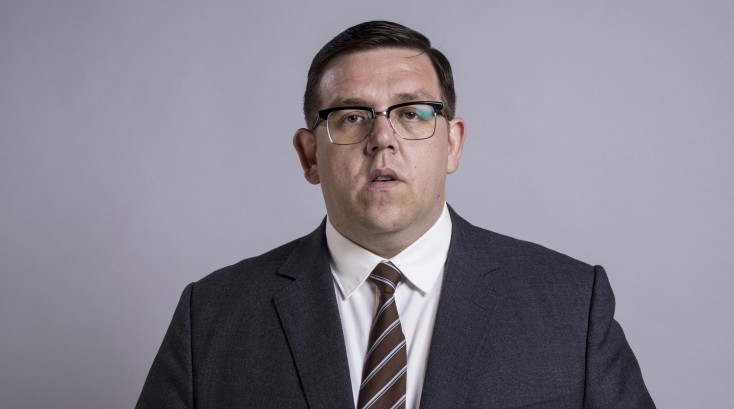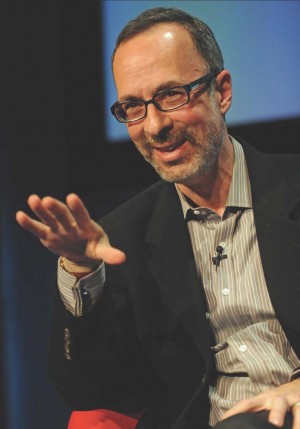By ANGELA DAWSON
Front Row Features
HOLLYWOOD—Inspiration can come from almost anywhere if you know where to look.
Take, for example, Robert B. Weide, the renowned writer/producer/filmmaker, best known for his collaboration with Larry David on the HBO comedy “Curb Your Enthusiasm.”
Weide was stuck in traffic on one of Southern California’s notoriously crowded freeways one day when he spied an interesting looking motorist next to him.
“He looked sort of like a very conservative Nick Frost,” Weide recalls by phone referring to the stout British comedian often paired with fellow funnyman Simon Pegg.
“He had a crew cut and horn-rimmed glasses,” he continues, as though giving an eyewitness account to the police. “He was wearing a jacket and tie. He had a real straight-laced look. He appeared as Nick Frost probably would have in the 1950s or 1960s. And my imagination started to run away with me.”
A broad picture quickly came into focus as Weide recorded his thoughts into his phone as he inched along the roadway. He imagined Jeremy Sloane as an ordinary British chap who can’t catch a break. His wife, the center of his world, has left him. He loses his office job and winds up working as a substitute teacher, who finds out the hard way that the instructor he’s subbing for is newly deceased and much beloved. That and other woes plague the series’ antihero, whose one joy is hanging out at the local pub with his motley friends. The comedy is set in the Swingin’ Sixties, but Sloane, by all appearances and attitude, is stuck in the post-war ‘50s.
Weide contacted Frost, whom he knew through Pegg, and told him about his idea, and that he saw the actor as the lead character he was writing. Frost was delighted. Thus was born “Mr. Sloane,” a character Weide fleshed out into a six-part series for Britain’s Sky Atlantic. It aired there last year.
Weide, who had directed the 2008 comedy “How to Lose Friends & Alienate People,” based on the Toby Young bestseller, created, wrote and directed the series that will air in Southern California on KCET and nationally through Link TV (DirecTV channel 375 and DISH Network channel 9410), which will host a marathon of all seven episodes on Sunday, May 17 at 8 p.m. ET/ 9 p.m. PT.
“Mr. Sloane” features a supporting cast including Olivia Colman (“Broadchurch”), Ophelia Lovibond (“Elementary”), Peter Serafinowicz (“Whitechapel,” “Guardians of the Galaxy”), Lawry Lewin (“Dr. Who”) and Brendan Patricks (“Downton Abbey”).
The series airs at 10 p.m. PT for three weeks starting Thursday, May 7 on KCET. Two episodes will air back to back the first week. The next two air back to back the following week, and the final three will air consecutively the third week.
Weide grew up in Southern California’s Orange County, where he began his lifelong love affair with telling stories visually by inspecting 16mm films for the Fullerton Public Library. While in college, he made a documentary about The Marx Brothers. When he was just 22 years old he met author Kurt Vonnegut and convinced him to allow him to make a documentary about him. That project has been in the works for more than 30 years (the author died in 2007), but should be completed by the end of the year, Weide says.
The genial filmmaker has made other documentaries about renowned comedians including W.C. Fields, Woody Allen and Lenny Bruce. More recently, he served as executive producer and principal director on acclaimed “Curb,” for which he received an Emmy award.
Q: You had Nick Frost, whom you knew, in mind from the outset. But how did you come up with Olivia Colman as his wife?
Weide: I also was friendly with Olivia, and wrote the part of the wife, Janet, for her. Although, unlike Nick, she didn’t know about it. When I was finished with it, I said to her, “I’ve got a script for you to read. Let me know if you like this because I wrote it for you and I’d love for you to play it.” Fortunately, she did like it. Her schedule sort of opened up at the last minute and I had my dream cast.
Q: I would imagine it added some cost to set the series in the late ‘60s.
Weide: Yeah, the period just rippled through the entire budget.
Q: Why 1969?
Weide: I liked the idea that this supposedly was the time of Swingin’ London, and I liked the idea that this guy would not be part of his own time but would actually be part of an earlier era, and instead of listening to Beatles records, he’s listening to Gilbert and Sullivan. I liked the idea that this culture revolution is sort of passing him by. He meets an American girl named Robin (Lovibond) who gets him to try pot for the first time and we have the idea of him being slowly indoctrinated by her into popular culture—that means music, that means going out to clubs. We have the idea that his wife has left him to find herself. Those were the kinds of things that appealed to me about that era. It all started with the look of a guy. That sort of drove the rest of it.
I also like the idea of doing a show where everybody isn’t on their cell phones, and you don’t have to look on computer screens where people are Googling. But, yeah, setting in the ‘60s did affect the budget, the schedule, and it certainly affected the locations and how many extras we could hire. We couldn’t just advertise for 100 extras to show up. We had to dress them all and do their hair and all that, so it was a real challenge. I think it was worth it because the people who lived during that era have looked at the show and have verified how authentic it looks and how nostalgic it is.
Q: There were six episodes altogether?
Weide: Yes. There were six that were done in England but the original British pilot was an hour. Here in the U.S., they’ve split it into two half hours, so it’s seven episodes.
Q: Can you talk about your own comic sensibility and who inspired you?
Weide: Certainly with regard to my documentaries, these are all my cultural influences, going back to my own adolescence. I discovered The Marx Brothers in eighth grade. That was it. I can say that seeing “Duck Soup” on TV one night changed my life. I’m working on a documentary on Kurt Vonnegut right now. I discovered him in high school. He not only became my favorite author but also my author, almost at the exclusion of anyone else. W.C. Fields came a little later as did Woody Allen. I was nine years old when (Allen’s) first movie came out. I loved that.
So I’ve always tried to pay tribute to my own influences while at the same time developing my own comic voice. I had a good long run with Larry David, who’s an old friend of mine on “Curb Your Enthusiasm.” I got a lot of offers to do “Curb”-like things after that series but I don’t like repeating myself. “Mr. Sloane” felt very different, although it does have some occasional themes like “Curb Your Enthusiasm.”
It’s a very different show; a very different look, a very different character, a different time and place, but I’m always project to project; it’s whatever captures my interest at the time. Consequently, my resume’s all over the place. There doesn’t seem to be any rhyme or reason to it other than I have yet to put my time and energy into a project that doesn’t excite me.
Q: One of the scenes that could have come out of a “Curb Your Enthusiasm” episode was Jeremy Sloane’s peanut discussion with his mates in Episode 2.
Weide: Although that’s a little more “Seinfeld”-like. You can imagine George and Jerry having that conversation at the diner. That was something that occurred to me on an airplane. I was on a flight that had no peanuts. I thought, “How could they be out of peanuts?” And then I thought, “Well, maybe they’re out of season.” And then I thought, “Wait, do peanuts have seasons?” I literally wrote down that dialogue, almost verbatim, in the pilot episode on a cocktail napkin. I said, “I have to use this somewhere.” So I got these four numbskulls together in a pub and figured that was the best time to whip out that peanut discussion. By the way, the actors who came in and auditioned for the show said that as soon as they read that scene, which is toward the end of the script, they actually Googled where peanuts come from, because they realized that they hadn’t thought about it before.
Q: Since you’d already made a film in Britain, was it easy to come up with British terms like “waste pipe” and “brolly?” Did it come naturally to you?
Weide: Some of it did, but there were enough British eyes on the script to always keep it in line. Sometimes, right before we’d shoot a scene, someone would say, “Uh, we really wouldn’t say ‘bathroom’ here, we’d say ‘toilet.’”
My producing partners in England, Big Talk Productions, checked on the historical accuracy. Like nobody uses directory assistance anymore because just go online to find phone numbers, but I remember, as a kid, you’d dial 411. In 1969, if you lived in Watford, England, if you called directory assistance, we found out how they’d answer the call. So it was those kinds of questions that I could always throw at them, and get an answer back, so that was very helpful.
Q: Is there going to be a second season?
Weide: I see this as a single series (season). I imagined the opening scene and I imagined the ending scene. I wanted it to end at the stroke of midnight 1970 because everyone’s looking forward to the beginning of the new decade to wipe the slate clean and to change their lives, so I thought it would be interesting with all this talk of the coming decade to bring it right up to that moment. I still get Facebooked and Tweeted all the time asking if there is going to be a second series. But I think this story works as a stand alone.
Q: Are you working on anything with Larry David?
Weide: That door’s always open but Larry’s doing his Broadway show now. Whether or not he’s going to want to go back to “Curb,” I don’t know. It’s been almost four years now since the last season aired so at this point, if we did another season, which wouldn’t go on for at least two years from now, it would almost be like a reunion show. It’s been so long. It’s always been an open-ended thing with HBO. We had an open invitation to come back whenever Larry felt like it. Even during those first several seasons, we’d finish a season and it would start to air, and I’d be doing other stuff and Larry would be doing other stuff, and then eventually there would be a call from Larry saying, “Do you want to do another one?” I suppose it could happen again but I would say it’s more unlikely than likely, but you never know.
Q: What’s happening with your Kurt Vonnegut project?
Weide: We just did a Kickstarter campaign, which ended successfully. We raised $300,000, and we’re back in business now. We’re in production, and looking to have the film now after 33 years. If not this year, (it will be out) towards the beginning of next year. It’s called “Kurt Vonnegut: Unstuck in Time.”






